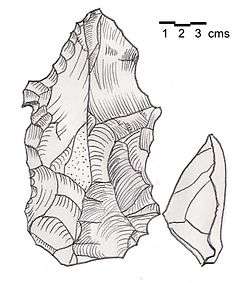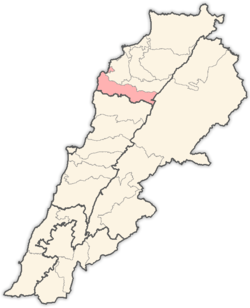Kfar Abida
Kfar Abida كفرعبيدا is a village located 2 kilometres (1.2 mi) south of Batroun in the Batroun District of North Governorate in Lebanon.[1]
Kfar Abida Kfarabida, كفرعبيدا كفرعبيدا | |
|---|---|
Village | |
| Country | |
| Governorate | North Governorate |
| District | Batroun District |
| Elevation | 700 ft (200 m) |
| Population (2007) | |
| • Total | 9,613 |
 Shown within Lebanon | |
| Location | 2 kilometres (1.2 mi) south of Batroun, Lebanon |
|---|---|
| Region | North Governorate |
| Coordinates | 34.226389°N 35.66°E |
| History | |
| Periods | Heavy Neolithic, Neolithic |
| Cultures | Qaraoun culture |
| Site notes | |
| Condition | Ruins |
| Public access | Yes |

Archaeological sites
Tell fadousتل فدعوس
Tell fadous تل فدعوس is a tell in the southern of KfarAbida that was first reported on by R. Wetzel and J. Haller in 1945 above the cemented beach deposits at 6 metres (20 ft).[2] A few Levallois flint flakes were found in part of the site on top of a dune.[3] Recent studies by Hermann Genz and Hélène Sader from the American University of Beirut have shown that the tell was inhabited up until the Early Bronze Age when it was abandoned in the late third millennium BCE.[4][5] Ralph Pederson from the University of Marburg also conducted a study in the maritime archaeology of the coast around Tell fadous تل فدعوس. Pederson suggested that the locale of "tell fadous تل فدعوس
" could have been used as harbourage by Bronze Age fishermen, as attested to by remains of fish and seashells found at the tell. He also found a neolithic flint blade in the shallows at Tell fadous تل فدعوس .[6]
Fadous Sud جنوبي فدعوس
Fadous Sud جنوبي فدعوس is a Heavy Neolithic site of the Qaraoun culture located south of the tell, some 300 metres (980 ft) south of the village Kfar Abida. It was discovered by Maurice Tallon in 1957 between the sea and the road. The site was found to extend east of the road in 1966 by W.E. Wendt, when material was recovered and the site examined by Lorraine Copeland and Henri Fleisch . The large site covers the 400 metres (1,300 ft) either side of the main road up to the side of a wadi.[7]
Fadous Sud جنوبي فدعوس proved to be an enormous Heavy Neolithic flint factory site with finds forming a wide-ranging assemblage in grey flint and cream chert that included large cores and flakes as well as scrapers, rabots, long blades, end scrapers, racloirs and a group of triangular flakes. Material from the beach had a whiter patina than that found nearer the road. The assemblage showed distinct similarities to that of the Heavy Neolithic type site at Qaraoun II and was classed as Neolithic. The finds were stored with the Saint Joseph University.[7] A new study of this lithic site south of Tell fadous تل فدعوس was carried out in 2005 by Dörte Rokitta-Krumnow.[8]
References
- Robert Boulanger (1966). The Middle East, Lebanon, Syria, Jordan, Iraq, Iran, p. 178. Hachette. Retrieved 9 July 2012.
- Wetzel, R. & Haller, J., Le Quartinaire de la région de Tripoli. Notes et Mémoires de la Délégation Générale de France au Liban. Section Géologique, No. 4, Beirut, 1945.
- Lorraine Copeland; P. Wescombe (1965). Inventory of Stone-Age sites in Lebanon, p. 85,. Imprimerie Catholique. Retrieved 21 July 2011.
- Genz, H. and Sader, H. 2007 Excavations at the Early Bronze Age Site of Tell fadous تل فدعوس : Preliminary Report on the 2007 Season of Excavations. Bulletin d’Archéologie et d’Architecture Libanaises 11: 7-16., 2007.
- Riehl, S. and Deckers, K. (2007). Plant Remains. In: H. Genz. (ed) Tell fadous تل فدعوس (Lebanon). Baal 9, 84-88.
- fadous تل فدعوس Pederson, Ralph., The Underwater survey at Tell fadous تل فدعوس , pp. 17-23, BAAL 11, 2007.
- L. Copeland; P. Wescombe (1966). Inventory of Stone-Age Sites in Lebanon: North, South and East-Central Lebanon, p. 158. Impr. Catholique. Retrieved 3 March 2011.
- Rokitta D., A lithic site southeast of Tell fadous تل فدعوس : Preliminary observations. Baal 9 (2005) 100-101.
External links
- fadaous - Pederson, Ralph., The Underwater survey at Tell fadaous, pp. 17-23, BAAL 11, 2007.
- American University of Beirut, Department of History and Archaeology - The Tell fadaous -Lebanon Archaeological Project. An Archaeological Documentation of a Partly Bulldozed Tell
- Localiban - fadaous
- Geographic.com -fadaous
- Ex-oriente Dr. Dörte Rokitta-Krumnow
